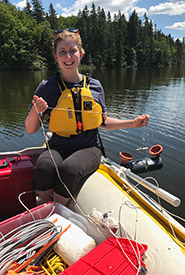When it comes to wetland restoration and maximizing soil carbon storage, location matters
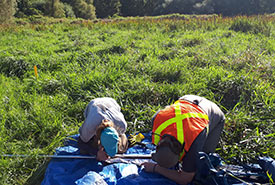
A day in the field at the Long Point Biosphere Reserve (Photo by Amanda Loder)
As appreciation from the public grows for the ecological and cultural values of wetlands, there is increasing demand to bring back those wetlands that have been converted or altered. Wetlands were once widespread across the temperate region of Canada, especially around the Great Lakes and in what is now southern Ontario. But since Europeans began colonizing these areas in the 18th century, wetlands have been widely drained for farmland. In southern Ontario where intensive agriculture occurs, some regions have experienced more than 85 per cent wetland loss since European settlement. Although these important ecosystems are still susceptible to several pressures and disturbances, there is growing interest in restoring wetlands and their important functions and values, especially where wetland losses have been major.
Wetland protection and restoration have been garnering attention recently as “natural climate solutions” to help reduce greenhouse gas emissions and slow the pace of climate change while providing other benefits (i.e., biodiversity, flood water storage, water quality improvement) and cultural value. When wetlands are drained, they release carbon dioxide due to the decomposition of their soil carbon stores. Restored wetlands, however, retain carbon stores in their soil and can simultaneously take up carbon from the atmosphere. But, questions remain on how much soil carbon is stored in undrained marshes. How quickly can carbon stores be recovered after a wetland is restored from its altered or converted state? Do protection and/or restoration serve as viable approaches for providing climate change mitigation? This is further complicated by the fact that wetlands release methane, a potent greenhouse gas, which must be considered in a restored wetland’s carbon balance.
To answer these questions, we continued research in the Long Point Biosphere Reserve on the northeast shore of Lake Erie in southern Ontario. In this segment of our research, we sampled soils from actively restored freshwater marshes managed by the Nature Conservancy of Canada in Norfolk County. These restored sites ranged between one to eight years in age (i.e., since active restoration took place) at the time of sampling (hereafter the actively restored wetlands). In addition, we sampled soils from a wetland that was accidentally restored without active intervention when a farmer abandoned the land in the 1950s. We conducted soil carbon and geochemical analyses, and compared measurements from these sites to that of an undrained site which served as a reference point.
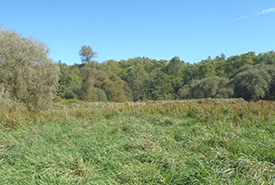
Undrained site (Photo by Amanda Loder)
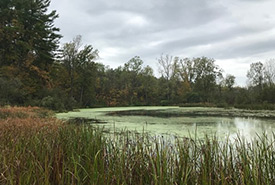
Passively restored site (Photo by Amanda Loder)
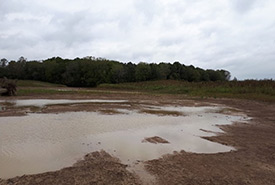
Actively restored site one year since restoration. (Photo by Amanda Loder)
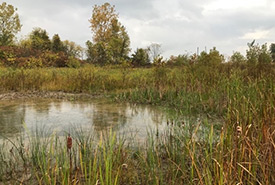
Actively restored site eight years since restoration (Photo by Amanda Loder)
The undrained site has soils comprised of organic carbon stores that have been accumulated and stabilized down to 4.3 metres in depth over the last 6,000 years. The passively restored site has been burying organic carbon over the last few decades - a comparatively shorter timeframe - but at times, rates of apparent organic carbon accumulation have been as high as rates found in other undrained marshes. What these two sites have in common is their low elevation on the Big Creek riparian floodplains where they experience inputs of water and materials from river flooding which aid in burying organic carbon. In examining the actively restored sites, we found that these sites have not accumulated significant amounts of organic carbon within eight years of active restoration. Instead, restored sites that are underlain by mostly clays and silts, and located on low-lying terrain, have higher organic carbon stocks and a better capacity as a natural climate solution than those underlain by sand on more elevated terrain.
This research highlights the importance of protecting intact undrained wetlands, which have soil organic carbon that has taken thousands of years to accumulate and is vulnerable to being released to the atmosphere if drained. This longer timescale over which organic carbon has been buried enables carbon inputs to outweigh the releases of methane from wetlands, and thus generates a net cooling effect on our climate. Unfortunately, these carbon stores are not recoverable within decades following restoration during which climate mitigation targets are set. But where restoration is viable and can provide additional ecosystem service benefits, strategically situating restoration sites where large stores of soil organic carbon still exist and where organic carbon burial and other ecological functions can be sustained will be extremely important to an overall reduction of greenhouse gas emissions from managed lands.
This research is published in Restoration Ecology and available through open access. It is co-authored by Sarah Finkelstein (University of Toronto), Sophia Zamaria (University of Toronto) and George Arhonditsis (University of Toronto Scarborough).
We thank Liv Monck-Whipp and Brett Norman at NCC for their great support and insight in making this research a success.

